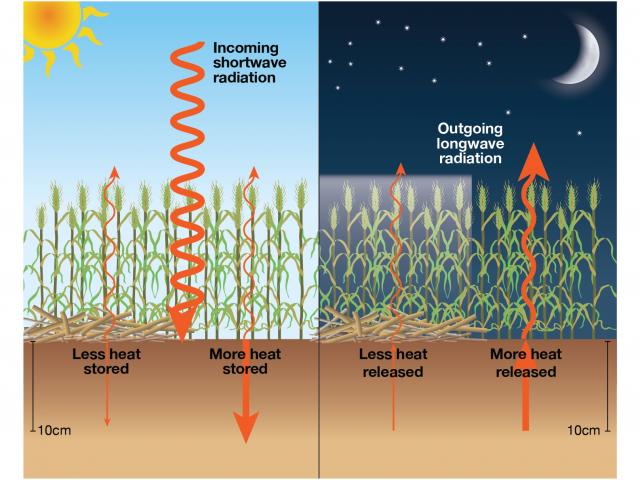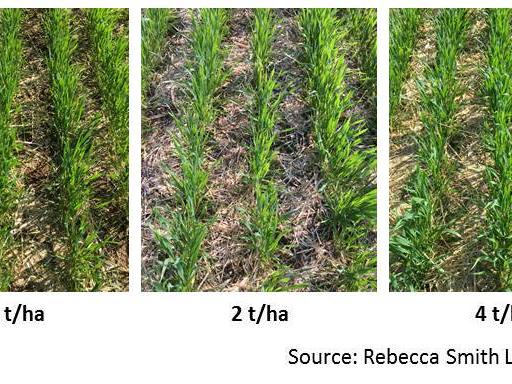Stubble management
Increasing the soil heat bank is an important factor in reducing the risk of frost. The soil heat bank refers to the residual heat captured in the top 10cm of the soil profile during the day. Overnight this heat is released into the canopy to warm flowering heads thus minimising frost damage.

Manipulating stubble loads as a tool to help reduce frost risk has been a focus of DPIRD/GRDC research trials since 2013. It has been shown that stubble loads can alter spring frost duration and severity. This is driven by the stubble load restricting heat flow in and out of the soil. For example, the temperature of the air above high stubble loads is more likely to be colder at night, due to the straw and other mulches acting as an insulator.
The key findings from extensive large scale trials are:
- Reducing stubble load reduced the severity and duration of frost events and resulted in less frost damage and better yields under frost. No differences were observed between stubble height, orientation or composition. Data to date suggest it’s mainly a load issue.
- In frost prone parts of the landscape growers can minimise frost risk by reducing stubble loads back to grain yield potential, prior to seeding. This can be achieved by various approaches including cutting low, windrow burning/chaff carting, stubble mulching, raking and burning, strategic blanket burning and summer grazing.
- Without frost, once off stubble reductions did not reduce yield and may give a slight improvement in yield due to reduced disease and less nitrogen tie up, depending on site, season and variety choice.
- With multiple severe frost events, stubble reduction did not increase yield.
Although stubble retention is a very desirable farming systems practice in terms of decreasing soil erosion, increased water content and soil biological activity, a compromise must be reached to ensure frost risk is reduced. Thresholds appear to be site-specific. In terms of minimising frost risk, a good rule of thumb is that stubble loads should match grain yield. For example, in a low production environment, 2t/ha grain yield potential = 4t/ha stubble and the stubble load needs to be halved at seeding, back to 2t/ha to minimise frost risk. In a medium production environment with 3t/ha grain potential = 6t/ha stubble, which needs to be reduced to 3t/ha to minimise risk. This calculation assumes a harvest index of 0.5. See images below to get a visual of stubble loads ranging from 1-4t/ha.
Stubble management and wind erosion
Balancing stubble management in terms of frost with minimising water and wind erosion risk will come down to individual paddock histories and future planning. Burning stubbles is one option to reducing stubbles however this method should be used strategically to ensure erosion risks are minimised. Burning in windrows is preferred over blanket burning when wind erosion is the primary concern. However, there are some situations when blanket burning is recommended.
For instance:
- Blanket burn strategically when stubble loads from previous seasons are unmanageable. For example when tyned seeding machinery is not able to handle the high levels of accumulated stubble between windrows after two or more high-yielding years.
- Blanket burn when crops have been frosted. Frosted stubble rots off at ground level and does not remain standing during seeding causing trashflow issues.
Where blanket burning will occur it is recommended to focus blanket burns on the risk areas (frost, resistant weed seeds, disease carry over and to improve herbicide efficiency) and to burn 2-3 days in front of the seeding bar to reduce wind erosion.
Soil amelioration
Strategic deep ploughing with mouldboard, one-way and square ploughs or rotary spaders can overcome topsoil water repellency and help overcome subsoil constraints resulting in greater plant establishment and vigour. Amelioration of repellent sands may reduce frost damage by improving the capacity of the soil to absorb and then release heat. Increased heat absorption by the soil can occur as a result of improved wetting and changes to the colour of the soil surface.
In 2014, a trial at Brookton was assessed to determine if alleviating the water repellent surface soil will be able to accumulate a greater thermal mass to radiate through the crop canopy and reduce the level of crop damage in a frost event. Yield differences were observed between the ameliorated and untreated plots in trials in 2014 and 2015, however the measured yield increases were partly a result of improved crop establishment and growth from overcoming the water repellency and other constraints by soil inversion . There were no consistent reductions in frost severity or duration, in the two years of trial work, hence the higher yield of the ameliorated soil was largely due to improved yield potential from overcoming soil constraints, rather than a reduction in frost damage.
In 2016, as in previous seasons, there was a lot of anecdotal evidence around the impact of soil amelioration during a frost event. Some growers reported reduced frost damage in paddocks that have been mouldboarded spaded delved or clayed. However there are many confounding factors occurring as a result of the soil amelioration making it difficult to narrow down impacts to a reduction in frost damage alone.
Amelioration impacts on:
- nutrient availability, particularly K
- reductions in water repellency
- change in soil colour
- soil water
- crusting
- reduction in root diseases
- improvements in establishment
- biomass
- delayed flowering
- yield potential.
Soil amelioration options can give longer term production benefits but are slow and expensive to implement. Therefore they need to provide significant long-lasting productivity benefits year-in and year-out in order to provide a good return on investment. The decision to undertake soil amelioration should be made primarily in regard to weed control, soil water repellency, subsoil constraints and profitability. Potential reductions in frost damage are an additional potential benefit in years when frost is an issue and soil amelioration is unlikely to be economically feasible practice for frost damage alone. Research is continuing to further understand the possible impacts of soil amelioration on frost severity and the impact of soil types and amelioration methods.

